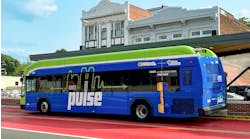Why It’s the Ideal Time to Modernize Transit Fare Collection?
While next-generation fare management technology supporting contactless cards and digital wallets have been around for some time, we are now seeing wider adoption of these payment options among consumers and businesses. In 2016, InfoScout reported that the number of people who’ve installed digital wallet Apple Pay and used it at least once was higher than ever before. Furthermore, consumers are increasingly using digital wallets when making in-store purchases as more businesses are now accepting them as payment options.
As contactless cards and digital wallets become more mainstream, U.S. transit agencies must prepare to meet the shift in payment preference. Accenture recently surveyed transit riders in eight North American cities who have taken public transportation in the last six months to learn what could help improve their ridership experience. The findings revealed that 51 percent of transit riders never have a paper fare card. Additionally, 57 percent said the ability to travel across different modes of transportation according to their preferences and make one payment automatically once their journey is complete is of interest. Integration of all forms of payment into a seamless journey will be what the market demands in the near future.
These new payment options won’t fully replace transit cards or even cash, but they do present an opportunity for transit agencies to begin transitioning away from having to manage their own fare media — a costly expense. New payment options also enable transit agencies different ways to partner with financial institutions and retailers to simplify the payment experience for their customers. To make this happen efficiently and effectively, fare management technology must be open, flexible and modern to keep pace with changes occurring now as well as those to come in the future.
Canada is another market where the use of contactless is on the rise. To date, 75 percent of Canadian retailers accept contactless payments and nearly 10 percent of all domestic transactions are contactless and growing at one percent per month.
In 2012, Presto, an electronic fare card system, conducted a pilot program at two Toronto subway stations where customers were able to use contactless credit cards and digital wallets to pay for their transit fares. As part of the Presto Next Generation rollout, the pilot program enabled the expansion of Presto to new forms of electronic payment and account-based features. Today, more than 2 million Presto cards are activated, an increase of nearly 600,000 in one year, with growth expected to continue. With the rollout of Presto infrastructure to the Toronto Transit Commission scheduled for completion at the end of 2016, Presto is poised for large-scale adoption of contactless credit cards and digital wallets aiding overall the Presto card expansion. Smart investments in fare management technology has allowed Presto to maintain flexibility on how and when new customer features are introduced.
The first generation of contactless smart card fare payment systems have been in operation between 10 and 20 years. The technology lifecycle for systems is between three to five years. These first generation contactless smart card fare payment systems do not have the capabilities required to adopt digital fare payment without an extensive investment. Investing in a modern fare payment system versus upgrading an antiquated technology provides a system that is design to evolve along with technology into the future.
As new partnerships for transit related services emerge, customers do not want to manage multiple payment channels. By taking the customer’s view, modernizing a fare payment system provides the foundation to streamline payment for multiple services associated with a single journey. Customers, especially millennials, are increasingly seeking alternatives to driving a single occupancy vehicle, thus combine different modes to create a journey. Just as public transit serves as the primary service, such as a train ride; the beginning or end of the journey may include any combination of parking, bicycle or on-demand ride service. So, the fare payment platform may serve as the core payment system.
And this is only the beginning. By investing in flexible, open technologies, U.S. transit agencies can benefit from massive cost-saving opportunities. Implementing digital technology helps improve transit planning, introduces new partnerships, integrates fare payment systems, and delivers real-time safety information. In this era of constant connectivity, people are already seeing the possibilities wireless connectivity can bring and this will only increase the pressure on transit agencies to deliver.
Michael Wilson is the managing director, Transportation with Accenture.



